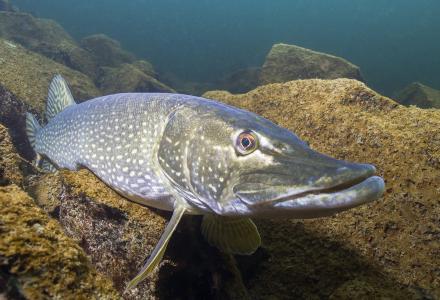
Since the 1960s, the International Joint Commission (IJC) has focused much of its attention on nutrients in the Great Lakes and made many related policy recommendations to the Canadian and US governments. Algal blooms in Lake Erie were a major focus of the first Great Lakes Water Quality Agreement (GLWQA) of 1972. The IJC, through its Great Lakes advisory boards, continues to study and make recommendations about nutrients, nutrient management and water quality.
Nutrients are the food that nourishes various organisms that make up the base of the food web. These organisms make their own energy; they include plants, algae and some bacteria. Nutrients are essential for growth and good in the right balance, but in excess they can create conditions for poor water quality. Each of the Great Lakes ecosystems needs its own balanced diet of nutrients. The right diet supports a healthy food web. Algae are an important foundation of a lake’s food web, but large algal blooms can be a nuisance or have harmful impacts on aquatic life and water quality.
Nutrients get into water through point sources like pipes from wastewater treatment plants, and nonpoint sources like fertilized farm fields or other lands such as forested areas. In 2018, the IJC published a report on fertilizer application trends in the western Lake Erie basin. The report found that commercial fertilizer is the primary source of phosphorus from agricultural sources overall. A 2019 supplemental report published by the Great Lakes Science Advisory Board (SAB) – Science Priority Committee included additional data and estimated that overall agricultural applications have declined slightly in recent years, although commercial fertilizer use has increased in Canada.

Credit: IJC (see full infographic here)
While commercial fertilizer dominates in the western Lake Erie basin, manure from concentrated livestock feeding operations is a concern throughout the Great Lakes region. While manure has nutrients that help crops grow, applying excessive amounts of manure to fields, or at the wrong times, can pollute waters.
In late 2019, the Great Lakes Water Quality Board (WQB) published a report on the rules governing manure management at concentrated livestock facilities, accompanied by an infographic. The report recommends that Great Lakes states and provinces coordinate and consistently regulate storing and applying manure to land, using Ontario as a model for a policy framework.
The WQB has since held webinars to gather feedback on the feasibility of implementing the report’s recommendations. In April, the board hosted a by-invitation webinar for agriculture producers and nongovernmental organizations. In May, the board held a public webinar to answer questions; the webinar recording is available to replay here.
Later this year, the WQB will summarize key messages from the feedback received and provide the IJC with lessons learned and advice on next steps to address the issue of manure management policy in the Great Lakes basin.
When it comes to the data used to estimate the magnitude of nutrient loading into the waterways, both the SAB and the WQB reports identified considerable data gaps. Scientists and managers use monitoring data and computer models to measure, track and forecast nutrient loadings. However, the gaps in the data available often limit the accuracy of these computer models.
In a 2019 report, the SAB Research Coordination Committee examined the use of modeling approaches to affect nutrient management through adaptive management. When it comes to managing nutrient loads to the western and central Lake Erie basin, the report recommends improved coordination across models and agencies through an adaptive management framework.
The IJC Great Lakes advisory boards’ recent reports focused on the overabundance of nutrients in the lakes and their impacts in the nearshore. A forthcoming report by the SAB Science Priority Committee, due later this summer, examines the food web complications that can occur when there are declining nutrient levels in the offshore regions of the lakes.
At a binational level, the GLWQA sets “nutrient load” targets for each lake. Lakes Michigan-Huron, Ontario and the eastern basin of Lake Erie continue to experience nuisance algae blooms along their nearshore bays and beaches. But, at the same time, the total phosphorus concentrations in these offshore areas are declining below the target. Scientists posit that this is, in part, because the phosphorus gets “trapped” in the nearshore by invasive zebra and quagga mussels and nuisance algae. This disrupts the food web in the offshore areas, starving native fish of their food sources.
The forthcoming report from the SAB Science Priority Committee is the product of a multi-year research project that updated current data on trends for nutrients and offshore fish production, and explored the state of the science to examine the likely causes of declining productivity of fisheries in lakes.
From commercial fertilizer and manure application in fields, to the impact of nutrient loadings on fish productivity, the IJC Great Lakes advisory boards continue to study and report on the latest advances in matters of nutrient science and policy. The Commission and its advisory boards expect that their advice will assist the governments’ nutrients-related work, particularly their actions and programs under Annex 4 of the GLWQA.

Allison Voglesong Zejnati is public affairs specialist at the IJC’s Great Lakes Regional Office in Windsor, Ontario.



